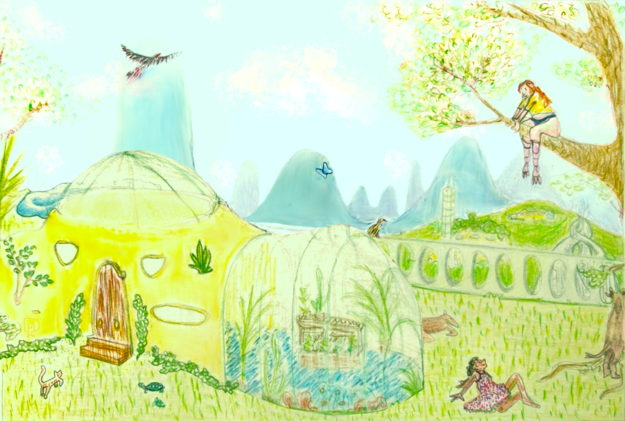Coined in 2008, the term "solarpunk" found its roots in a blog post titled "From Steampunk to Solarpunk", envisioning a new speculative fiction subgenre. This movement converges environmentalism, technology, and art, providing a positive yet realistic response to contemporary issues. Matt Staggs, in 2009, introduced the "GreenPunk Manifesto", outlining a vision of a technophilic genre with a focus on achievable, do-it-yourself technologies driving positive ecological and social change.
Derived from sci-fi currents like Cyberpunk, Steampunk, and Dieselpunk, solarpunk also draws inspiration from climate sci-fi, Indigenous, and Afro-futurist science fiction. The movement is a space for counter-cultural hope, providing alternatives to social-ecological injustices and promoting alternative ways of relating to the world.
Solarpunk's identity, depicting futuristic architecture with the visual influence of Art Nouveau, embraces natural colors, vibrant greens, and blues. Unlike the dark and grim aesthetics of cyberpunk, solarpunk radiates brightness, using light as a motif to convey transparency, abundance, and equity. Artists like Olivia Louise have shaped the movement's aesthetic, drawing inspiration from natural forms and integrating diverse cultural elements.
In contrast to the nihilism of cyberpunk and the reactionary tendencies of steampunk, solarpunk authors express commitment to "ingenuity, generativity, independence, and community". Lee Konstantinou describes solarpunk as aspirational, offering suggestions for the kind of science fiction or fantasy that aligns with a hopeful vision.
"Hopepunk is a technology of optimism, [that]…requires bravery and strength…It’s about standing up and fighting for what you believe in. It’s about standing up for other people. It’s about DEMANDING a better, kinder world, and truly believing that we can get there if we care about each other as hard as we possibly can, with every drop of power in our little hearts"
- A. Rowland
Solarpunk extends beyond literature and art to become an activist movement. It seeks to decolonize energy, challenging the exploitation of energy as a vector for neocolonization that disproportionately affects indigenous and peasant communities. This involves envisioning potential futures that break away from the monopolization of territories under the guise of renewable energies.
Solarpunk, with its emphasis on sustainability, ecological harmony, and positive socio-technological change, can be viewed as a tangible concretization of posthuman ideals. Posthumanism, as a philosophical perspective, challenges traditional notions of human exceptionalism and explores the coexistence and collaboration between humans and non-human entities.
At the heart of this fictional genre lies the symbiosis between humanity and nature, a key aspect of posthuman thought. The movement envisions a future where humans actively engage with and contribute to ecological systems, recognizing the agency of non-human entities.
Solarpunk, as posthumanism, seeks to integrate technology into the fabric of society for collective well-being. Unlike dystopian narratives that portray technology as a tool of control, this genre envisions a harmonious coexistence where advanced technologies are harnessed to enhance the quality of life and foster sustainable practices.
In solarpunk, the rejection of anthropocentrism aligns with posthumanism's call to move beyond human-centric perspectives; in fact, both movements challenge the traditional dichotomy between mankind and nature, presenting a future where human and non-human entities coexist and thrive together.
By envisioning and actively participating in the creation of alternative futures, solarpunk embodies the posthuman principle of shared responsibility for shaping a more sustainable and inclusive world.
In conclusion, solarpunk is more than a genre: it's a rebellion against pessimism, a space for collective imagination, and a movement that calls for collaborative processes of envisioning and materialization. Emerging as an aesthetic, philosophical, and activist movement, it invites individuals to participate in reimagining the relationship between technology, society, and nature, challenging colonial thought; with its optimistic and sustainable vision, it serves as a concrete realization of posthuman notions.
By fostering a symbiotic relationship between humans and non-humans, integrating technology for collective well-being, and challenging anthropocentrism, solarpunk offers a glimpse into a future where posthuman ideals shape a harmonious coexistence.
References:
- Katherine N. Hayles, "How We Became Posthuman: Virtual Bodies in Cybernetics, Literature, and Informatics" (1999)
- Donna J. Haraway, "A Cyborg Manifesto: Science, Technology, and Socialist-Feminism in the Late Twentieth Century" (1985)
- Rosi Braidotti, "The Posthuman" (2013)
- Ailton Krenak, "Ideias para adiar o fim do mundo" (2019)
- Adam Flynn, "Solarpunk: notes toward a manifesto"(2014)
- Solarpunk: a reference guide
- Begum Rokeya, "Sultana’s Dream" (1905)
- Emma Gillam, "Petro Past and Solar Future: an exploration of critical, creative and activist solarpunk discourse" (2023)

